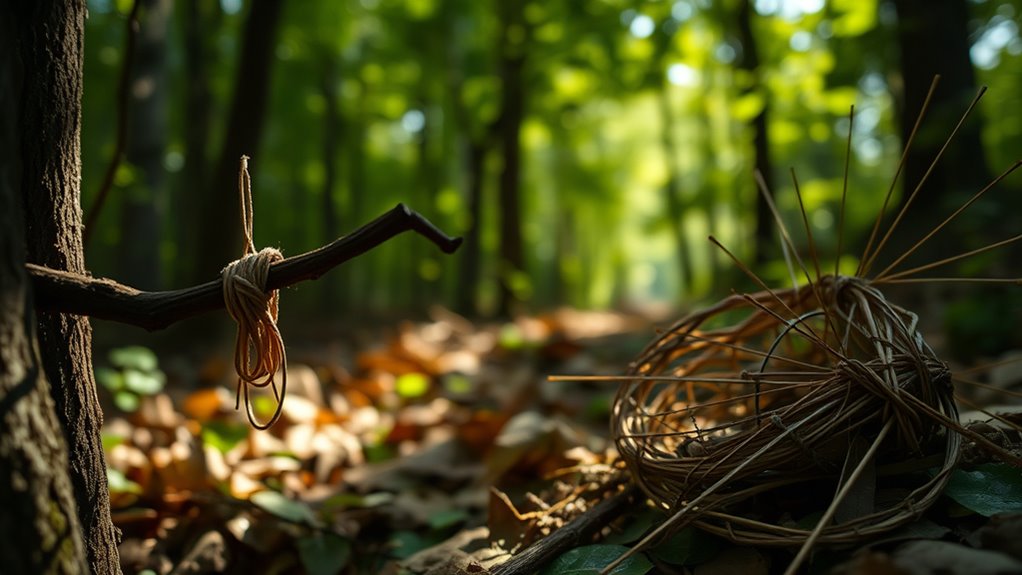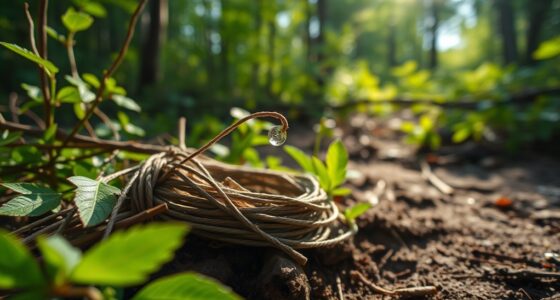To craft effective snares and traps for small game, focus on humane and ethical practices by researching your target animals’ habits and preferred bait. Place traps along animal trails, near signs of activity, and blend them into the environment to increase success. Use appropriate trap designs, secure bait effectively, and check them regularly for humane reasons. If you continue exploring, you’ll discover detailed tips to improve your trapping skills responsibly.
Key Takeaways
- Use humane trap designs that minimize suffering and comply with local laws.
- Select bait that appeals to the target species, such as nuts for squirrels or greens for rabbits.
- Place traps along animal trails, signs, and near cover to increase success.
- Position traps at appropriate height and orientation based on the target animal’s habits.
- Regularly check traps to ensure humane treatment, fresh bait, and quick response.

Have you ever wondered how hunters catch small game efficiently and ethically? It all comes down to understanding the basics of trap design, particularly bait selection and trap placement. When setting out to craft snares and traps, your goal is to attract your target animal without causing unnecessary suffering. The first step is choosing the right bait. Different animals are drawn to different scents and foods, so research what appeals to your target species. For example, rabbits might be attracted to fresh greens or carrots, while squirrels often go for nuts or seeds. Using appealing bait increases your chances of luring the animal toward your trap, making your setup more effective. Be sure to place the bait securely within the trap so it’s visible and accessible, but also positioned to encourage the animal to trigger the mechanism naturally.
Trap placement is equally vital. You want to identify signs of activity—tracks, droppings, or feeding areas—and set your trap along these well-used paths. Position your trap where the animal regularly passes or feeds, increasing the likelihood of a successful catch. When placing your trap, think about the animal’s natural behavior. For instance, if it tends to stick close to cover, set the trap near brush or behind logs, but make sure it’s still accessible for the animal to approach naturally. Avoid placing traps in open areas where they might be easily seen and avoided, or in spots where non-target animals or humans might accidentally trigger them. The idea is to blend your trap into the environment seamlessly, so it appears as a natural part of the animal’s routine. Additionally, understanding ethical considerations in trap design helps ensure humane treatment of animals and compliance with local regulations.
Furthermore, be mindful of the trap’s height and orientation. Most small game animals tend to travel along established trails close to the ground, so position your trap accordingly. Check the trap regularly to make sure that the bait remains fresh and enticing, and to respond quickly if you’ve caught your target. Proper trap placement also involves considering safety and ethics—never set traps in a way that could cause unnecessary pain or injury to non-target animals or people. By thoughtfully selecting bait and carefully placing your trap where animals naturally frequent, you increase your chances of a successful and humane catch. Remember, patience and observation are key; the more you understand your target animal’s habits, the more effective your trap will become.
Frequently Asked Questions
What Legal Considerations Are Involved in Setting Small Game Traps?
You need to follow legal regulations when setting small game traps, ensuring your trap construction complies with local laws. Check if permits are required and respect hunting seasons and area restrictions. Avoid setting traps in prohibited zones or using illegal methods. Familiarize yourself with state and federal regulations to prevent fines or legal issues. Always prioritize ethical trapping practices to stay within the law and protect wildlife populations.
How Do Weather Conditions Affect Trap Effectiveness?
Weather impact can considerably influence trap efficiency. Cold, rainy, or windy conditions may make animals less active, reducing your chances of catching prey. Conversely, warm, dry days often increase activity levels, improving trap success. You should also check for weather-related issues like flooding or snow that can disrupt or damage traps. By considering these weather impacts, you can adjust your trapping strategies for better results and maximize your chances of success.
What Are the Safest Methods for Trap Placement?
You should place your traps in safe, discreet spots, ensuring they’re concealed well with natural cover like leaves or brush. Bait placement is key; put bait where the animal naturally travels and make sure it’s visible but not obvious. Always check for signs of activity and avoid areas where children or pets could accidentally trigger the trap. Proper concealment and strategic bait placement keep everyone safe and improve your chances of success.
How Can I Identify Signs of Small Game Activity?
You can identify signs of small game activity by observing tracking clues like footprints, scat, and nibbled vegetation. Look for habitat signs such as fresh bedding, runways through grass or brush, and feeding areas with overturned leaves or gnawed bark. These clues indicate recent activity. Pay attention to the terrain and water sources, as small game often frequent these spots, making them ideal locations for setting traps.
What Are Eco-Friendly Alternatives to Traditional Traps?
You can go for eco-friendly alternatives like biodegradable materials, which vanish faster than your hopes of catching quick-moving small game. Humane trapping methods are also a game-changer, ensuring animals aren’t harmed but safely released afterward. These options are better for the environment, more ethical, and help you stay in harmony with nature. Switch to biodegradable and humane traps, and you’ll make a positive impact while still pursuing your outdoor adventures.
Conclusion
Now that you know how to craft snares and traps, you’re better prepared to hunt small game efficiently. Imagine yourself in a survival situation, setting a simple snare in the woods; with patience, you could catch a rabbit for dinner. Practice makes perfect, so try different designs and locations. Remember, respect wildlife and follow local regulations. With these skills, you’ll feel more confident and self-reliant in outdoor adventures or emergencies.









